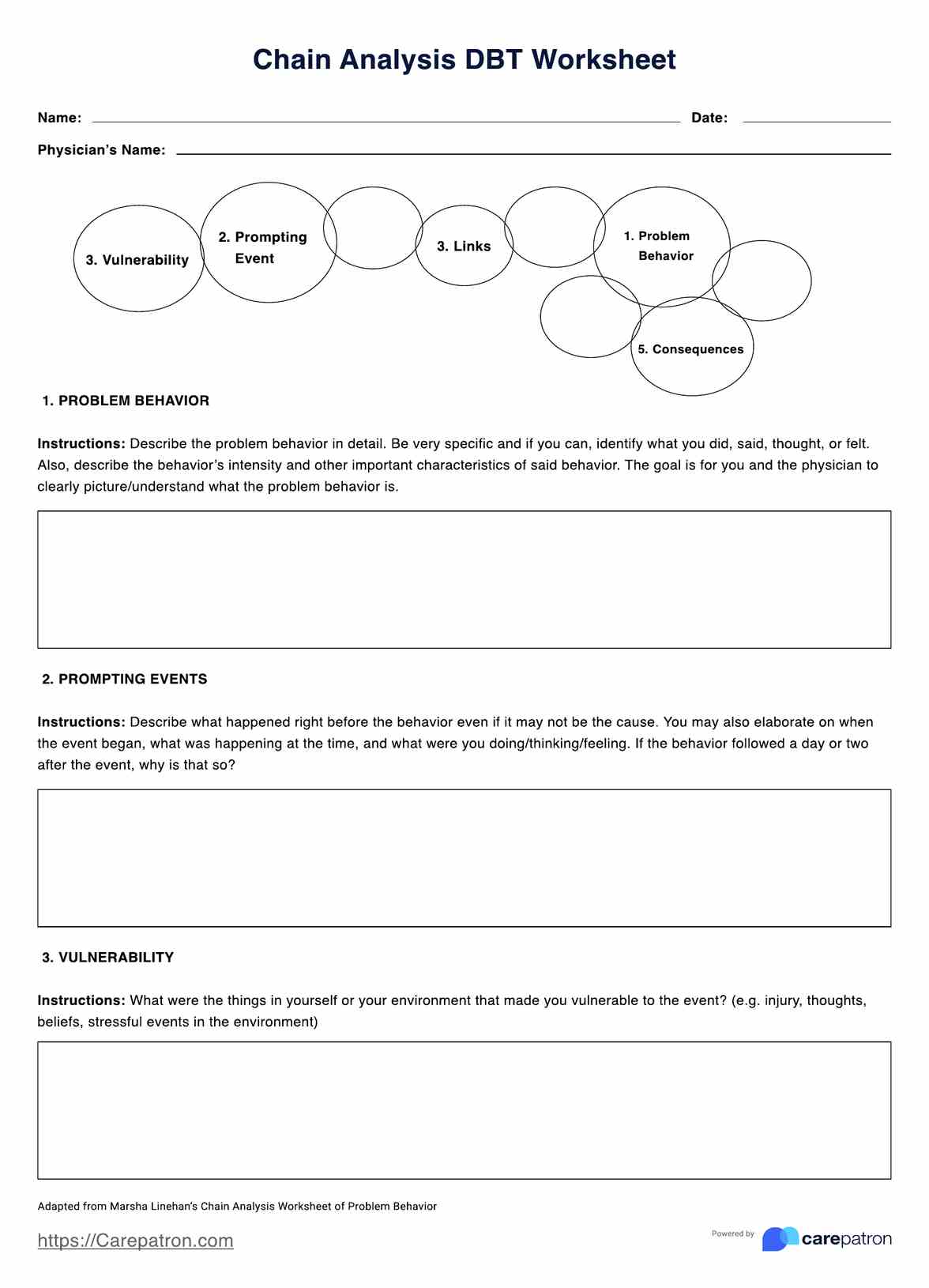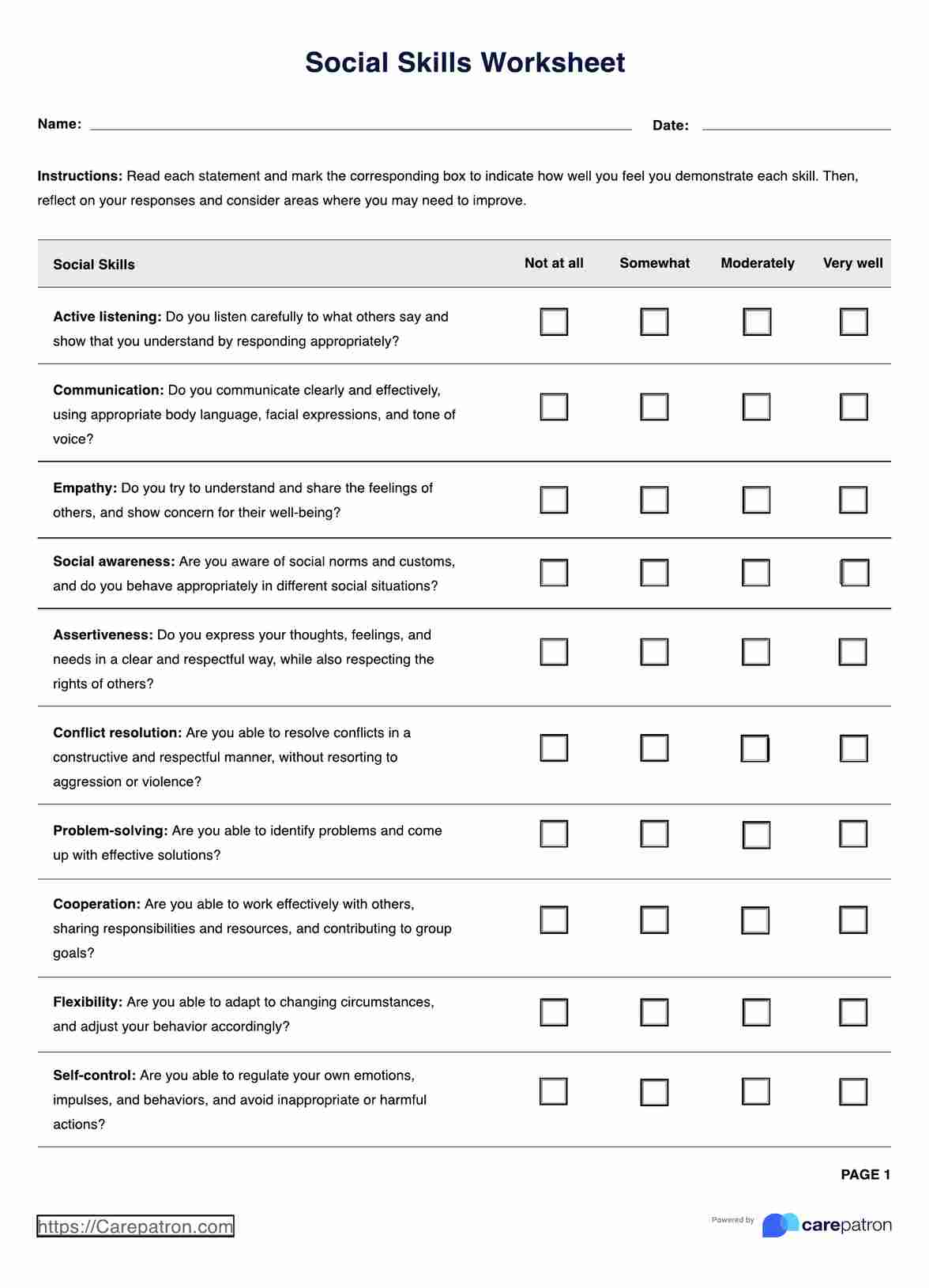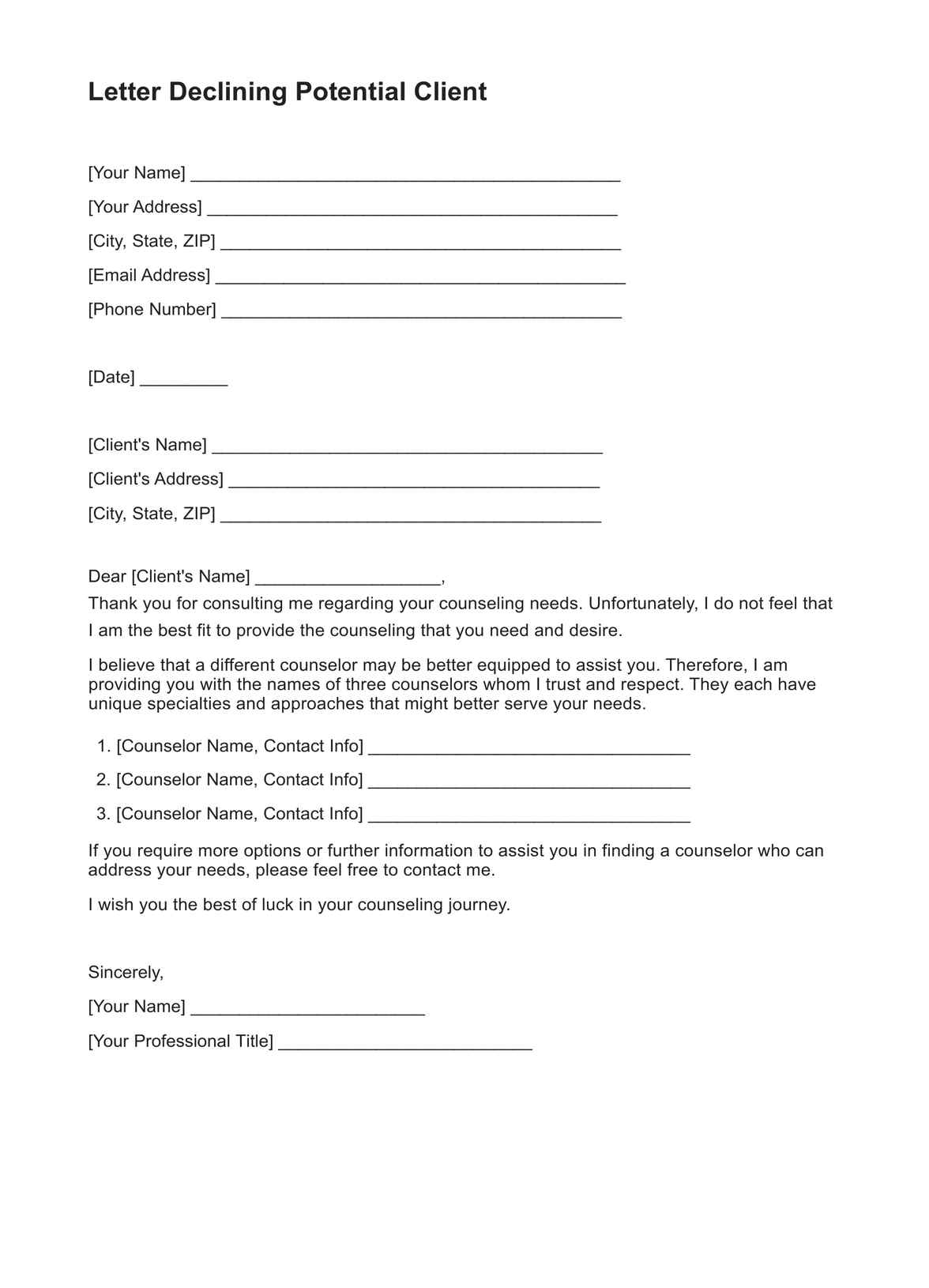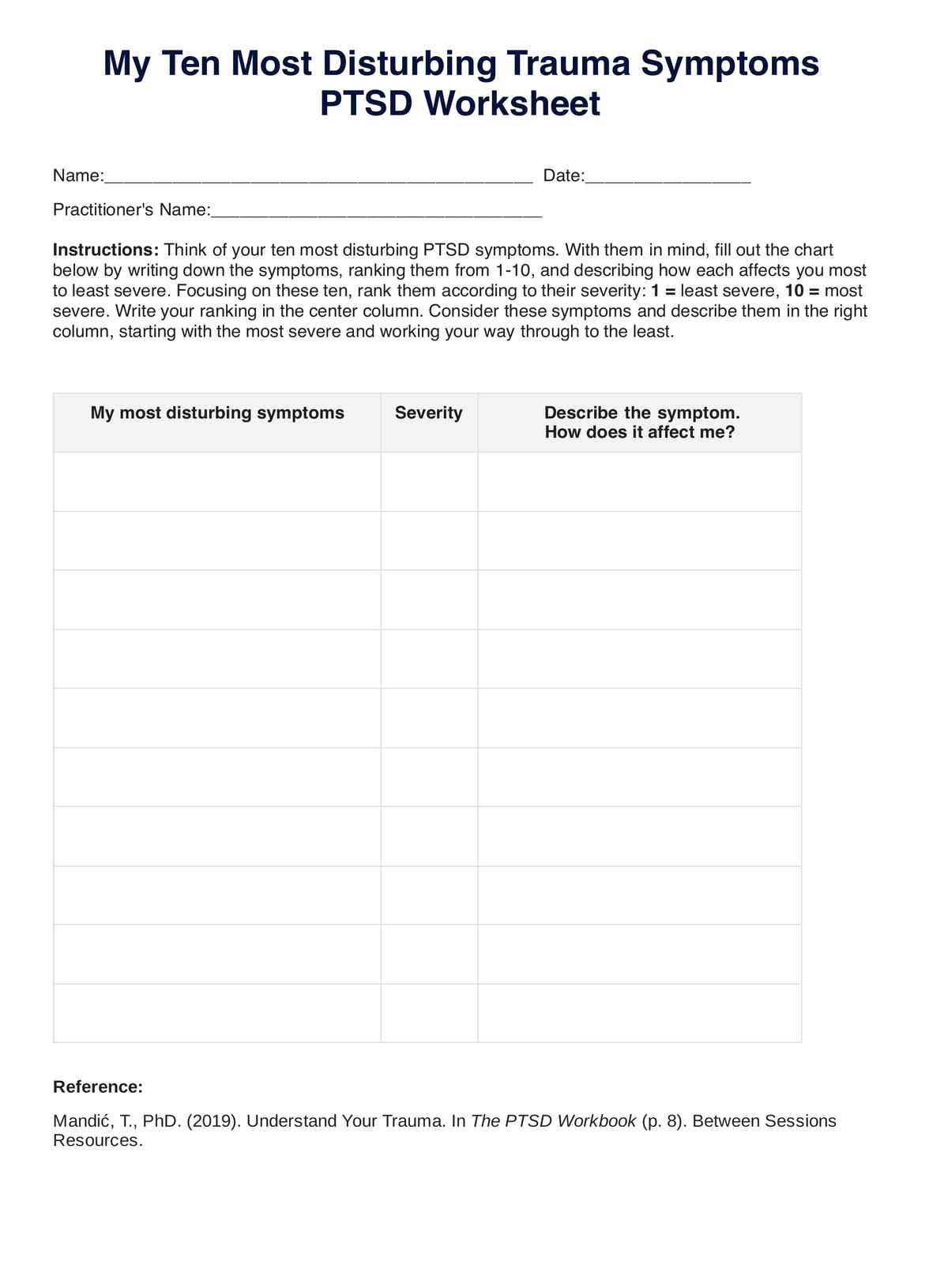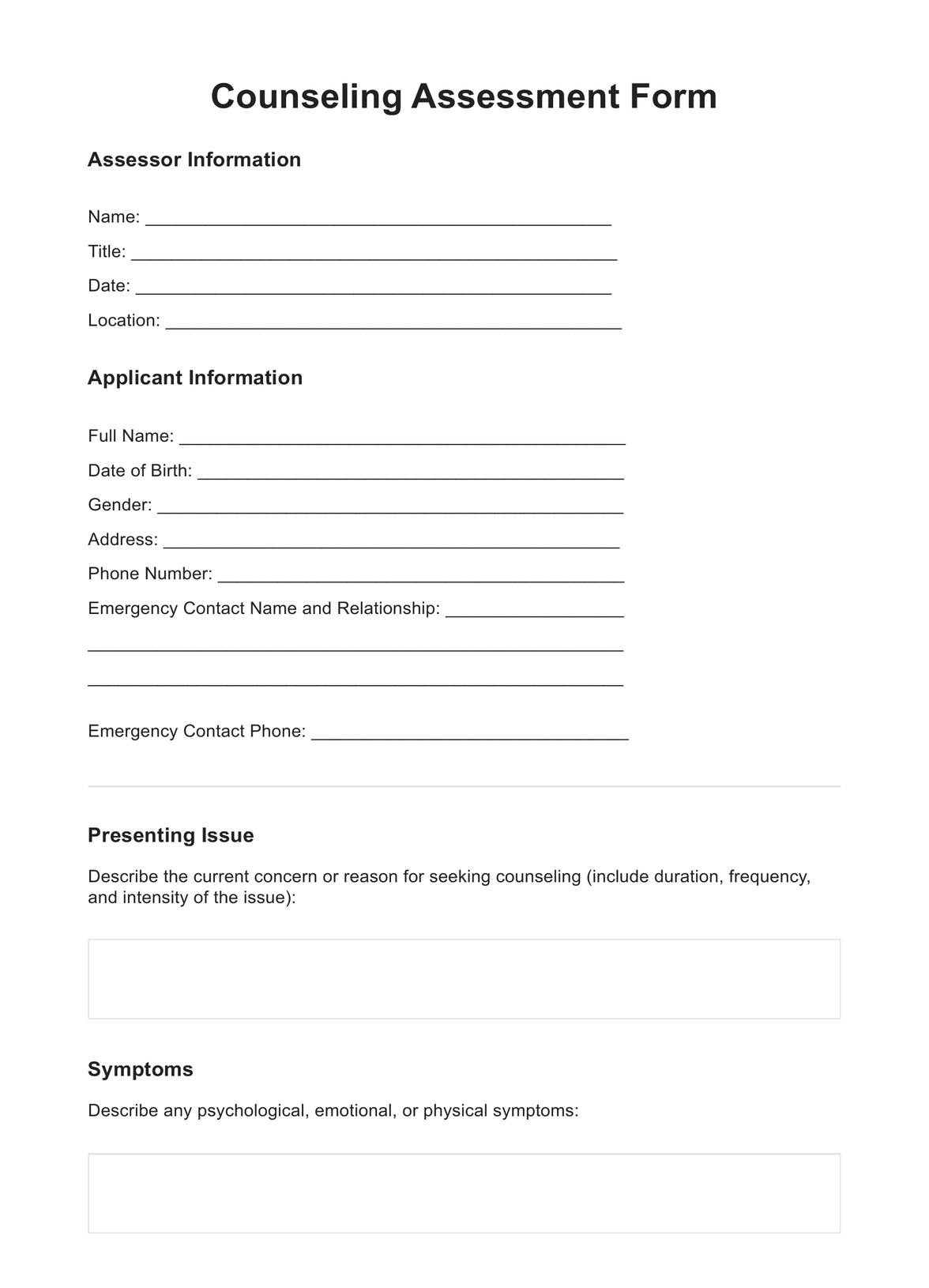Seligman's Four Strategies PTSD Worksheet
Explore Seligman's Four Strategies PTSD Worksheet and find an illustrative example. Learn how to apply these strategies for trauma recovery!


What is Trauma and PTSD?
Trauma, an intrinsic facet of the human experience, manifests in various forms and can have profound psychological repercussions. It is characterized by exposure to distressing events that exceed one's capacity to cope effectively. Such events can range from natural disasters and accidents to interpersonal violence and warfare.
Post-Traumatic Stress Disorder (PTSD) is a specific mental health condition that often arises as a consequence of experiencing trauma. It is categorized within the realm of anxiety disorders. It is marked by symptoms, including intrusive thoughts, nightmares, heightened arousal, and emotional numbing, all of which persist for an extended period following the traumatic event.
PTSD can be profoundly debilitating, impeding one's ability to function in daily life and maintain healthy relationships. Given its pervasive effects, numerous therapeutic approaches have emerged to assist individuals in recovering from trauma and managing the associated symptoms. One notable approach is the application of Seligman's Four Strategies, which provides a structured framework for individuals to enhance their resilience in the face of trauma.
In the following sections, we will delve into these strategies and how they can be utilized effectively in the context of trauma recovery.
Seligman's Four Strategies PTSD Worksheet Template
Seligman's Four Strategies PTSD Worksheet Example
How to Use the Seligman's Four Strategies PTSD Worksheet
Seligman's Four Strategies PTSD Worksheet is a valuable tool designed to aid individuals in their recovery from trauma and the associated symptoms of Post-Traumatic Stress Disorder (PTSD). Based on psychologist Martin Seligman's pioneering work, this worksheet provides a structured approach to address traumatic experiences and promote resilience.
Here, we will elucidate how to effectively utilize this worksheet, breaking down the process into key steps.
Step 1: Introduction and Preparation
Begin by introducing the worksheet to the individual seeking assistance in trauma recovery. Explain that it is designed to facilitate a cognitive shift in their perspective on the traumatic event and its aftermath. Ensure a comfortable and private environment for the individual to work through their thoughts and feelings.
Step 2: Identifying a Traumatic Event
Encourage the individual to reflect on a traumatic event in their life that they have experienced and subsequently moved on from. This event serves as the focal point for applying Seligman's Four Strategies.
Step 3: Applying the Strategies
a. Changing Interpretation Style: In this section, the individual should recount the traumatic event while changing their interpretation style from internal (self-blame) to external (objective assessment). Encourage them to consider the facts, seek input from others, and construct a holistic view of the event.
b. Changing from Global to Specific: Have the individual shift their perspective from viewing the traumatic event as a global catastrophe to understanding it as a specific incident that can be described in detail and quantified.
c. Changing from Permanent to Temporary: Guide them in altering their perception of the event's permanence. Encourage them to consider the possibilities of change and healing rather than assuming the trauma's effects are fixed.
d. Checking Locus of Control: Prompt the individual to assess their locus of control. Discuss the balance between internal and external attributions for the event and encourage them to find a middle ground.
Step 4: Reflect and Compare
Instruct the individual to read their description of the traumatic event, noting the changes in perspective resulting from applying Seligman's strategies. Have them compare their initial interpretation with the transformed one, considering which perspective seems more reasonable and constructive.
Step 5: Integration and Next Steps
Discuss how the revised perspective can inform their trauma recovery journey. Encourage them to integrate these insights into their daily life, focusing on resilience-building and well-being.
Seligman's Four Strategies PTSD Worksheet is a structured pathway to promote cognitive restructuring and enhance resilience in individuals navigating the challenging terrain of trauma recovery and PTSD management. It empowers individuals to regain control over their narrative, fostering a more adaptive and constructive outlook on life beyond trauma.
When to Use Seligman's Four Strategies PTSD Worksheet
Seligman's Four Strategies PTSD Worksheet is a valuable resource used in various scenarios to aid individuals in their trauma recovery journey and enhance their resilience. Here are some of the best and most appropriate times to use this worksheet:
Shortly After Traumatic Events
Using the worksheet shortly after experiencing a traumatic event can be highly effective. It allows individuals to address their emotional responses and thought patterns while the trauma remains fresh. Early intervention can help prevent the development of severe post-traumatic symptoms.
As part of Trauma Therapy
Mental health professionals, including psychologists, counselors, and therapists, can integrate Seligman's Four Strategies PTSD Worksheet into their therapy sessions. It is a structured tool that complements traditional therapeutic approaches and helps individuals reframe their experiences.
During Ongoing Therapy
Individuals undergoing therapy for PTSD or trauma-related issues can use this worksheet as part of their ongoing treatment plan. It provides a systematic way to work on cognitive restructuring and resilience-building, contributing to long-term recovery.
Self-Help and Self-Reflection
The worksheet can also be used as a self-help tool by individuals motivated to work independently on their trauma recovery. It offers a structured framework for self-reflection, allowing individuals to gain insights and progress at their own pace.
Support Groups
Support groups for trauma survivors can incorporate Seligman's Four Strategies PTSD Worksheet as part of their group activities. It encourages members to share their experiences and collectively apply the strategies, fostering community and mutual support.
In Schools and Educational Settings
Educators, school counselors, and mental health professionals working with students who have experienced trauma can use this worksheet to assist young individuals in processing their emotions and developing resilience.
Seligman's Four Strategies PTSD Worksheet is a versatile tool that can be applied in various contexts and by different individuals. It is most effective when used as part of a comprehensive approach to trauma recovery, whether in professional therapy or as a self-help resource. By applying these strategies, individuals can reframe their perspectives, reduce distress, and embark on a path toward healing and resilience.
Using the PTSD worksheet template can enhance your practice by offering a structured approach to assessing and addressing trauma-related symptoms. This tool facilitates comprehensive evaluation and supports the development of targeted therapeutic interventions for improved client outcomes.
Benefits of Using the Free Seligman's Four Strategies PTSD Worksheet
Utilizing Seligman's Four Strategies PTSD Worksheet offers a range of advantages for individuals seeking to address and recover from trauma-related challenges. These benefits are grounded in the principles of positive psychology and cognitive restructuring and are supported by research in the field. Here are six key advantages:
1. Enhanced Resilience
Research has shown that applying the strategies outlined in Seligman's model can enhance resilience. By shifting from internal to external interpretations and from permanent to temporary views, individuals can develop a more adaptive response to trauma (Seligman, 1998).
2. Reduced Psychological Distress
This worksheet aids in reducing symptoms of PTSD and associated psychological distress. By altering thought patterns and promoting cognitive flexibility, individuals can mitigate the emotional impact of traumatic experiences (Hoge et al., 2015).
3. Improved Coping Mechanisms
Users can learn effective coping mechanisms through this worksheet. It guides them to reframe their traumatic experiences, fostering a sense of control and promoting healthier coping strategies (Foa et al., 2007).
4. Clarity and Objectivity
The worksheet encourages individuals to view their traumatic events objectively, fostering clarity and perspective. Research suggests that this shift from a global to a specific perspective can lead to a more balanced understanding of the trauma (Zoellner et al., 2002).
5. Increased Self-Compassion
Individuals can develop greater self-compassion by checking their locus of control and finding a middle ground between self-blame and external attributions. This can lead to reduced self-criticism and increased self-esteem (Neff, 2003).
6. Empowerment
Ultimately, this worksheet empowers individuals to participate in their recovery actively. It equips them with practical tools and a structured framework for redefining their traumatic experiences, promoting a sense of control and self-efficacy (Seligman, 2006).
The free Seligman's Four Strategies PTSD Worksheet is a valuable resource for trauma survivors. It aligns with empirical research on trauma recovery and empowers individuals to take charge of their healing process, fostering resilience, reducing distress, and promoting psychological well-being.
Commonly asked questions
The time it takes to complete Seligman's Four Strategies PTSD Worksheet can vary from person to person. It depends on factors such as the complexity of the traumatic event, the individual's willingness to engage with the process, and their familiarity with the strategies. Generally, individuals may spend 30 minutes to an hour or more on the worksheet.
Seligman's Four Strategies PTSD Worksheet is valuable for reframing your perspective on traumatic events and building resilience. It guides you from self-blame to a more objective interpretation of the trauma, helping reduce psychological distress and improve coping mechanisms. By applying these strategies, you can gain clarity, emotional stability, and a sense of empowerment in your trauma recovery journey.
Seligman's Four Strategies PTSD Worksheet is designed for individuals who have experienced trauma and want to enhance their resilience and cognitive coping mechanisms. It can be used by anyone seeking to reframe their perspective on traumatic events, whether working with a mental health professional or using it for self-help. However, for individuals with severe trauma or PTSD, it is advisable to use this worksheet in conjunction with professional guidance and therapy.


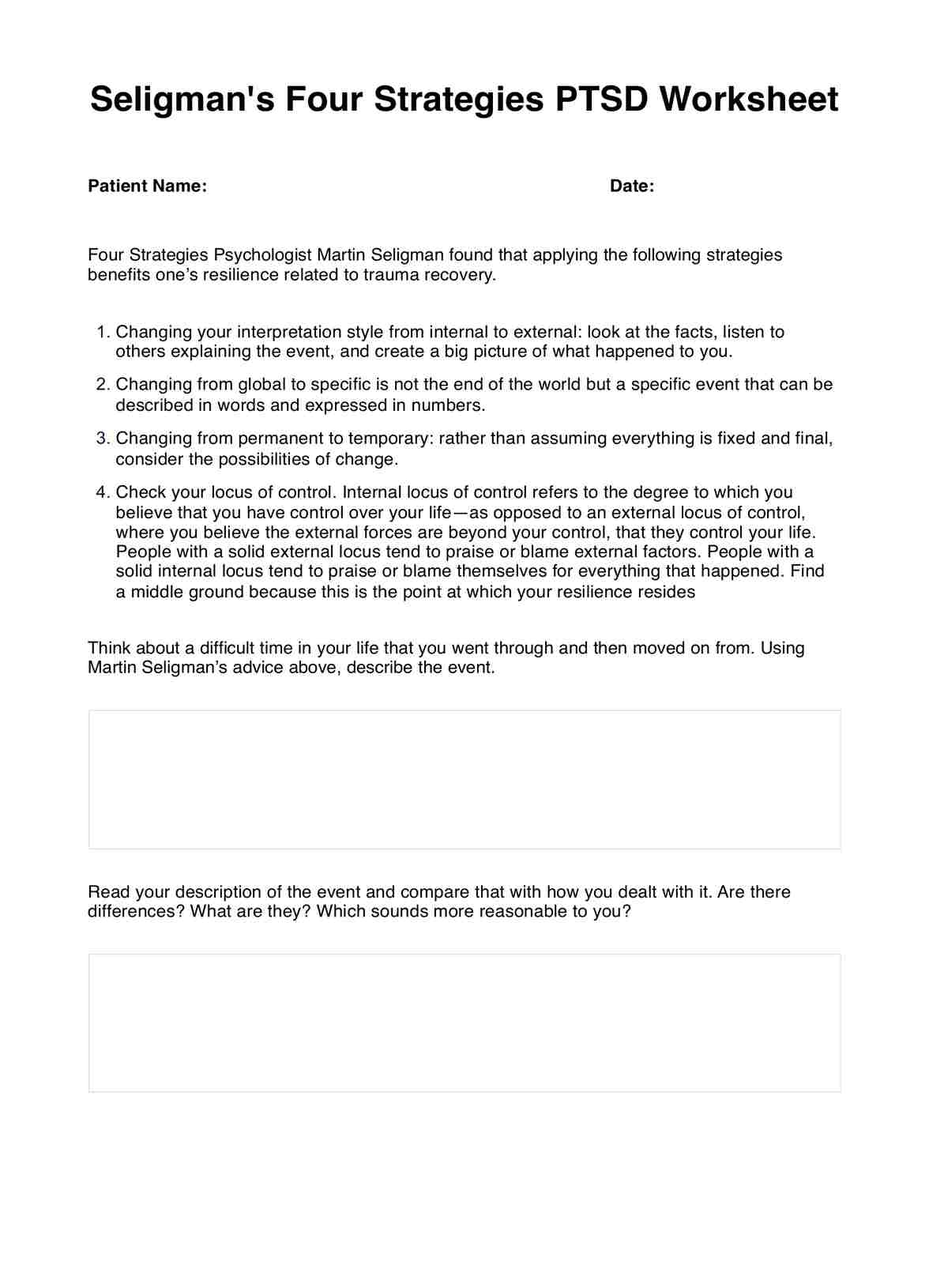
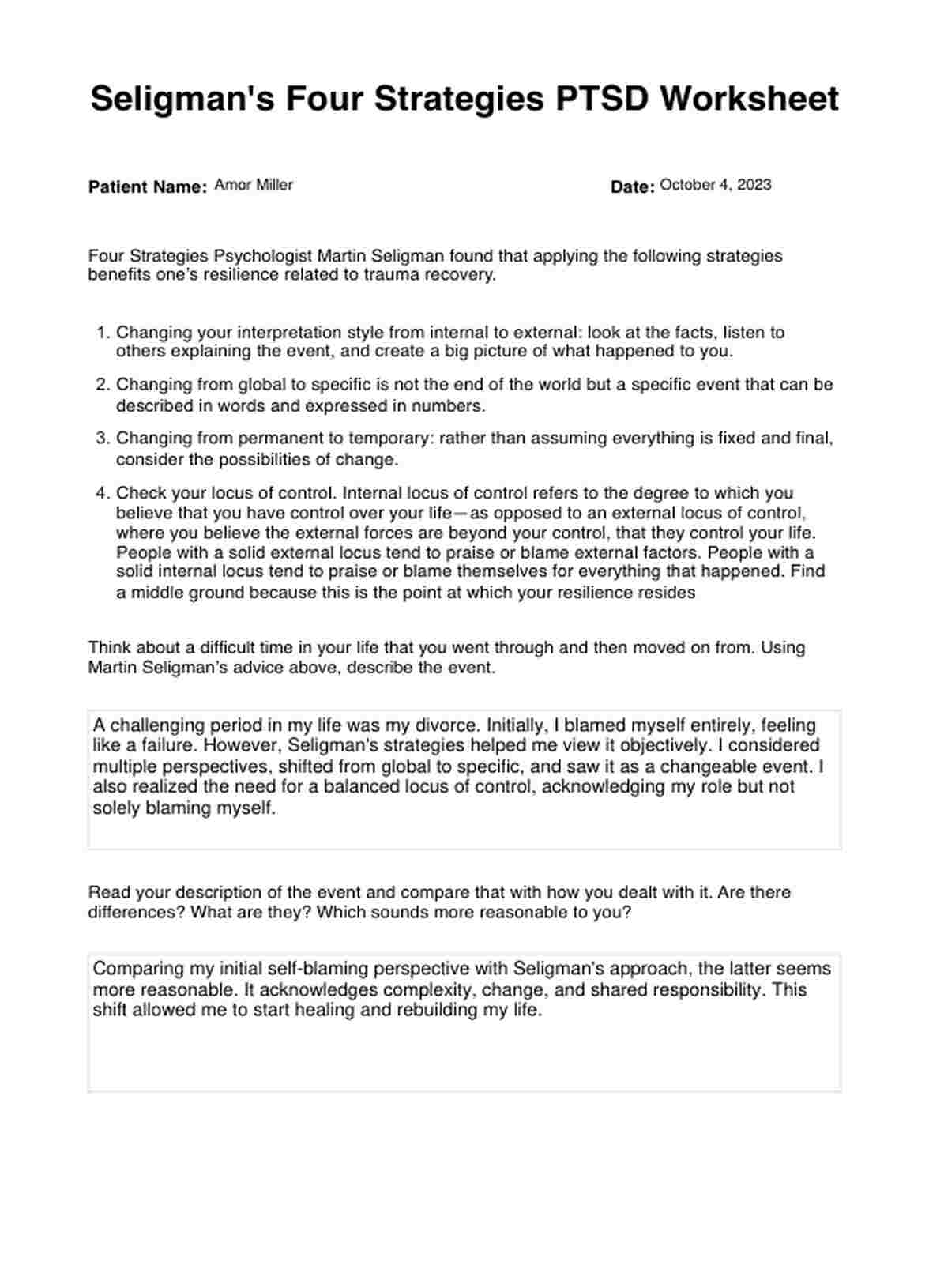
















-template.jpg)




















































































